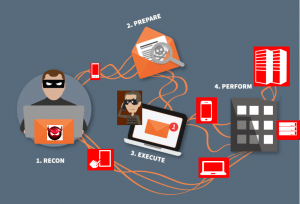
Previously, we discussed Social Engineering in the form of Phishing, a typically untargeted attack type that focuses on quantity over quality. However, not all Social Engineering attacks cast a large net, some get up close and personal. Attacks that involve pretexting are typically more focused and can be well planned and highly targeted; making them a credible threat to information security at any company.
Whether used in person or through other means of communication, pretexting is a dangerous method used by attackers to worm their way into systems and financial profit. Pretexting can be relatively simple and recycled constantly, but can also be well thought out, researched, and specifically tailored to each target. Ultimately, pretexting involves an attacker impersonating someone or having a “legitimate” reason to gain access where they do not belong. Pretexting relies heavily on an attacker having convincing and effective aliases, stories, identities, and credibility.
The research conducted to carry out a pretexting attack is typically all open source. They might scour an organization’s web pages to understand the size, structure, and relationships, or they might look for company login portals such as HR sites, mail hosting, and VPN portals. Often times, attackers will try to find information on specific employees like email addresses, position within the company, and any other information that can be used to impersonate or manipulate them. Gathering all of this information about an organization helps attackers in understanding how the business operates and what type of attacks might work. If the target is a large company with thousands of employees then an attempt to impersonate someone is more likely to be successful than if the target is a small close knit business that would easily recognize an imposter.
Thorough research enables attacker to determine the best methods to gain unquestioned access to money transfers, systems, and other restricted areas. A tactic that attackers frequently use is to impersonate a target’s boss, an executive, or other important figure, and then urgently request money transfers to specified accounts. The hope is that the targeted individual will panic due to the urgency and fail to verify the transaction with anyone else. Other attack types include impersonating vendors, internal departments, or other entities who might have an already established relationship with the organization. The attacker may try to call the victim and using their false identity and back story, then get them to visit a fake company login page and input their credentials. With those credentials, attackers can now access potentially sensitive systems and data.
Whether a Social Engineer uses a relatively general pretext, or a highly targeted and well planned one, users should be aware of and able to prevent the danger that they pose. Preventing these kinds of attacks is not necessarily difficult, it just takes a bit of time and diligence. If someone asks you to complete a wire transfer, take the time to confirm that they are the ones that sent the email or made the phone call. Reach out with another form of communication to verify. Always confirm any backstory that is offered to you, if you have been asked to log into a portal to accept new compliance documents or policies, contact your compliance office to double check. If someone visits the office and claims to work for a maintenance company but they aren’t on your schedule, call the corporate office and verify that their employee is supposed to be there. Confirm package deliveries from delivery people you have never seen before. Be highly suspicious of anyone who contacts you and asks for login credentials, personal information, or financial details over the phone or through email. Always be wary of strangers trying to access systems, data, and even your office building. Take the time to protect yourself and your organization from attackers who try to manipulate you with convincing and well thought out back-stories and personas.
-
Kennedy, D. (2014, March 05). Pretexting Like a Boss. Retrieved June 20, 2019, from https://www.trustedsec.com/2014/03/pretexting-like-boss/
Nadeem, M. (2019, April 17). Pretexting: Definition and examples | Social engineering. Retrieved June 20, 2019, from https://blog.mailfence.com/pretexting/

